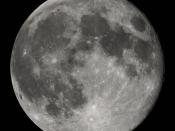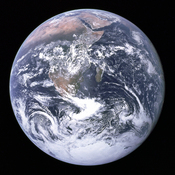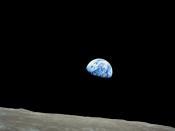The Moon is the only natural satellite of Earth. The distance from Earth is about 384,400km with a diameter of 3476km and a mass of 7.35*1022kg. Through history it has had many names: Called Luna by the Romans, Selene and Artemis by the Greeks. And of course, has been known through prehistoric times. It is the second brightest object in the sky after the Sun. Due to its size and composition, the Moon is sometimes classified as a terrestrial "planet" along with Mercury, Venus, Earth and Mars.
Origin of the Moon Before the modern age of space exploration, scientists had three major theories for the origin of the moon: fission from the earth; formation in earth orbit; and formation far from earth. Then, in 1975, having studied moon rocks and close-up pictures of the moon, scientists proposed what has come to be regarded as the most probable of the theories of formation, planetesimal impact or giant impact theory.
Formation by Fission from the Earth
The modern version of this theory proposes that the moon was spun off from the earth when the earth was young and rotating rapidly on its axis. This idea gained support partly because the density of the moon is the same as that of the rocks just below the crust, or upper mantle, of the earth. A major difficulty with this theory is that the angular momentum of the earth, in order to achieve rotational instability, would have to have been much greater than the angular momentum of the present earth-moon system.
Formation in Orbit Near the Earth
This theory proposes that the earth and moon, and all other bodies of the solar system, condensed independently out of the huge cloud of cold gases and solid particles that constituted the primordial solar nebula. Much of this...



Origin Of The Moon
You have writtin for your first ever essay a very detailed accound of the Theories on the Origin of the Moon in your own words. I must stress apon the importance of a biblography showing were your information came from. Yet thanks for a great first essay.
2 out of 3 people found this comment useful.